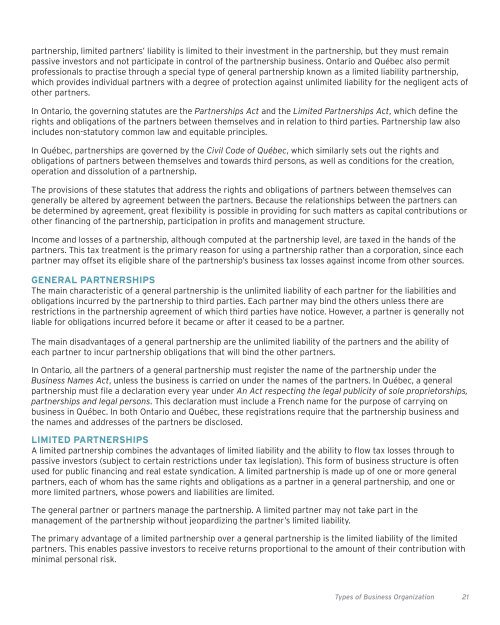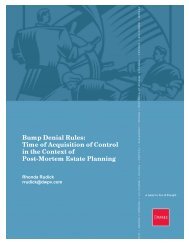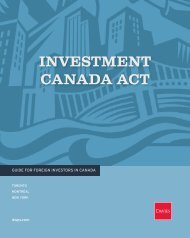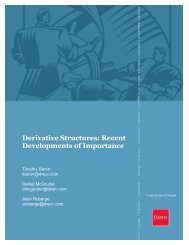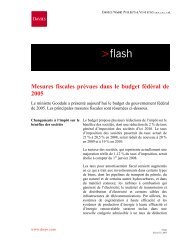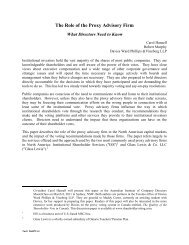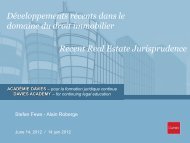The corporation may purchase <strong>in</strong>surance to cover the personal liability of the directors and officers, or<strong>in</strong>demnify them directly for such liability. However, <strong>in</strong>demnification will generally cover only those acts whichwere performed by the directors and officers <strong>in</strong> good faith. The CBCA, OBCA and QBCA permit broader<strong>in</strong>surance coverage to be ma<strong>in</strong>ta<strong>in</strong>ed, even <strong>in</strong> respect of acts contrary to directors’ and officers’ fiduciary duties,although such <strong>in</strong>surance may not <strong>in</strong> practice be obta<strong>in</strong>able at reasonable cost.SUBSIDIARY OR BRANCH?A foreign corporation may carry on <strong>bus<strong>in</strong>ess</strong> <strong>in</strong> Canada either through a branch or by sett<strong>in</strong>g up a newcorporation as a Canadian subsidiary. Tax considerations will be important <strong>in</strong> mak<strong>in</strong>g this choice, but the non-taxconsiderations discussed below may also be relevant.Most prov<strong>in</strong>ces <strong>in</strong> Canada do not provide for hybrid forms of corporate entity with certa<strong>in</strong> partnership-likecharacteristics. However, Nova Scotia, Alberta and British Columbia permit the formation of unlimited liabilitycompanies (“ULCs”), the shareholders of which do not have limited liability, but which are otherwise similar toord<strong>in</strong>ary corporations. Although a ULC is treated as a corporation for Canadian tax purposes, it is eligible forflow-through treatment for U.S. tax purposes. Therefore, ULCs are often used <strong>in</strong> cross-border transactions.However, as a result of the amended Canada-U.S. tax treaty, after 2010 it will be more complex for U.S. residentsto obta<strong>in</strong> beneficial tax treatment through the use of a ULC: see the Tax Considerations section of this guide.There are important differences between Nova Scotia, Alberta and British Columbia ULCs. In Alberta, theshareholders are liable for any liability, act or default of the ULC, whereas <strong>in</strong> Nova Scotia and British Columbia,the shareholders of a ULC have no direct liability to creditors and their liability arises only when the ULC iswound up or liquidated with <strong>in</strong>sufficient assets to satisfy its obligations.SubsidiaryIf the <strong>in</strong>corporation of a subsidiary is chosen, the cost of <strong>in</strong>corporat<strong>in</strong>g the corporation and the ongo<strong>in</strong>gexpenses of ma<strong>in</strong>ta<strong>in</strong><strong>in</strong>g it must be taken <strong>in</strong>to account. If it is <strong>in</strong>corporated under the OBCA or CBCA, it must beconsidered whether appropriate <strong>in</strong>dividuals who are resident Canadians are available to serve as directors.Certa<strong>in</strong> corporate records generally must be ma<strong>in</strong>ta<strong>in</strong>ed <strong>in</strong> Canada. The names of officers and directors are amatter of public record. The CBCA and OBCA do not require the disclosure of shareholders’ names on the publicrecord, but the QCA does and the QBCA will. S<strong>in</strong>ce the subsidiary is a separate legal entity from its parent, theparent will not generally be liable for obligations <strong>in</strong>curred by the subsidiary (unless the subsidiary is a ULC).BranchAn un<strong>in</strong>corporated branch may be chosen as an alternative to a subsidiary. The foreign corporation mustregister <strong>in</strong> all prov<strong>in</strong>ces <strong>in</strong> which it wishes to carry on <strong>bus<strong>in</strong>ess</strong>. The corporation cannot register if the name ofthe foreign corporation is the same as or similar to one already <strong>in</strong> use <strong>in</strong> that prov<strong>in</strong>ce. In addition, <strong>in</strong> Québecthe foreign corporation must register a French name. Bus<strong>in</strong>ess names used by a branch should also beregistered and should not be the same as or similar to names used <strong>in</strong> the prov<strong>in</strong>ce. A foreign corporation whichestablishes a branch <strong>in</strong> Ontario must obta<strong>in</strong> a licence under the Extra-Prov<strong>in</strong>cial Corporations Act, although thisis generally a rout<strong>in</strong>e requirement.PARTNERSHIPSPartnership is the relationship between persons carry<strong>in</strong>g on <strong>bus<strong>in</strong>ess</strong> <strong>in</strong> common with a view to profit. Partnersmay be <strong>in</strong>dividuals, corporations or other partnerships. In Canada, a partnership is not regarded as a separatelegal entity from its partners.There are two pr<strong>in</strong>cipal types of partnership. In a general partnership, all of the partners can participate <strong>in</strong>management of the <strong>bus<strong>in</strong>ess</strong>, but are exposed to unlimited liability for partnership obligations. In a limited20 Types of Bus<strong>in</strong>ess Organization
partnership, limited partners’ liability is limited to their <strong>in</strong>vestment <strong>in</strong> the partnership, but they must rema<strong>in</strong>passive <strong>in</strong>vestors and not participate <strong>in</strong> control of the partnership <strong>bus<strong>in</strong>ess</strong>. Ontario and Québec also permitprofessionals to practise through a special type of general partnership known as a limited liability partnership,which provides <strong>in</strong>dividual partners with a degree of protection aga<strong>in</strong>st unlimited liability for the negligent acts ofother partners.In Ontario, the govern<strong>in</strong>g statutes are the Partnerships Act and the Limited Partnerships Act, which def<strong>in</strong>e therights and obligations of the partners between themselves and <strong>in</strong> relation to third parties. Partnership law also<strong>in</strong>cludes non-statutory common law and equitable pr<strong>in</strong>ciples.In Québec, partnerships are governed by the Civil Code of Québec, which similarly sets out the rights andobligations of partners between themselves and towards third persons, as well as conditions for the creation,operation and dissolution of a partnership.The provisions of these statutes that address the rights and obligations of partners between themselves cangenerally be altered by agreement between the partners. Because the relationships between the partners canbe determ<strong>in</strong>ed by agreement, great flexibility is possible <strong>in</strong> provid<strong>in</strong>g for such matters as capital contributions orother f<strong>in</strong>anc<strong>in</strong>g of the partnership, participation <strong>in</strong> profits and management structure.Income and losses of a partnership, although computed at the partnership level, are taxed <strong>in</strong> the hands of thepartners. This tax treatment is the primary reason for us<strong>in</strong>g a partnership rather than a corporation, s<strong>in</strong>ce eachpartner may offset its eligible share of the partnership’s <strong>bus<strong>in</strong>ess</strong> tax losses aga<strong>in</strong>st <strong>in</strong>come from other sources.GENERAL PARTNERSHIPSThe ma<strong>in</strong> characteristic of a general partnership is the unlimited liability of each partner for the liabilities andobligations <strong>in</strong>curred by the partnership to third parties. Each partner may b<strong>in</strong>d the others unless there arerestrictions <strong>in</strong> the partnership agreement of which third parties have notice. However, a partner is generally notliable for obligations <strong>in</strong>curred before it became or after it ceased to be a partner.The ma<strong>in</strong> disadvantages of a general partnership are the unlimited liability of the partners and the ability ofeach partner to <strong>in</strong>cur partnership obligations that will b<strong>in</strong>d the other partners.In Ontario, all the partners of a general partnership must register the name of the partnership under theBus<strong>in</strong>ess Names Act, unless the <strong>bus<strong>in</strong>ess</strong> is carried on under the names of the partners. In Québec, a generalpartnership must file a declaration every year under An Act respect<strong>in</strong>g the legal publicity of sole proprietorships,partnerships and legal persons. This declaration must <strong>in</strong>clude a French name for the purpose of carry<strong>in</strong>g on<strong>bus<strong>in</strong>ess</strong> <strong>in</strong> Québec. In both Ontario and Québec, these registrations require that the partnership <strong>bus<strong>in</strong>ess</strong> andthe names and addresses of the partners be disclosed.LIMITED PARTNERSHIPSA limited partnership comb<strong>in</strong>es the advantages of limited liability and the ability to flow tax losses through topassive <strong>in</strong>vestors (subject to certa<strong>in</strong> restrictions under tax legislation). This form of <strong>bus<strong>in</strong>ess</strong> structure is oftenused for public f<strong>in</strong>anc<strong>in</strong>g and real estate syndication. A limited partnership is made up of one or more generalpartners, each of whom has the same rights and obligations as a partner <strong>in</strong> a general partnership, and one ormore limited partners, whose powers and liabilities are limited.The general partner or partners manage the partnership. A limited partner may not take part <strong>in</strong> themanagement of the partnership without jeopardiz<strong>in</strong>g the partner’s limited liability.The primary advantage of a limited partnership over a general partnership is the limited liability of the limitedpartners. This enables passive <strong>in</strong>vestors to receive returns proportional to the amount of their contribution withm<strong>in</strong>imal personal risk.Types of Bus<strong>in</strong>ess Organization 21
- Page 1 and 2: DOING BUSINESSIN CANADAYOUR COMPLET
- Page 3 and 4: ONTENTSTABLE OF CONTENTSINTRODUCTIO
- Page 5 and 6: IntroductionPOLITICAL AND CONSTITUT
- Page 7 and 8: 5RealEstateIndustrial and Intellect
- Page 9 and 10: accordance with directions from the
- Page 11 and 12: TITLE INSURANCE, TITLE OPINIONS AND
- Page 13 and 14: 11EnvironmentalLawIndustrial and In
- Page 15 and 16: commercial activities, or carrying
- Page 17 and 18: The federal government currently re
- Page 19 and 20: 17Types ofBusiness OrganizationIndu
- Page 21: provincial law cannot do so as of r
- Page 25 and 26: parties. In Québec, joint venturer
- Page 27 and 28: 25Financing aBusiness OperationIndu
- Page 29 and 30: The Civil Code of Québec provides
- Page 31 and 32: 29CorporateGovernanceIndustrial and
- Page 33 and 34: Instrument 58-101. The practices re
- Page 35 and 36: 33CompetitionLawIndustrial and Inte
- Page 37 and 38: BID-RIGGINGBid rigging is any agree
- Page 39 and 40: anticompetitive agreements among co
- Page 41 and 42: 39ForeignInvestmentIndustrial and I
- Page 43 and 44: apply for Canadian citizenship. (Pe
- Page 45 and 46: (D)GENERAL REVIEW THRESHOLDSThe fol
- Page 47 and 48: there be an "acquisition of control
- Page 49 and 50: Industrial and Intellectual Propert
- Page 51 and 52: to perform or cause them to be perf
- Page 53 and 54: Registration grants an exclusive ri
- Page 55 and 56: PIPEDA applies in all provinces of
- Page 57 and 58: Employment LawCanadian employment l
- Page 59 and 60: displacement, laying-off, suspensio
- Page 61 and 62: easonable cause to believe that the
- Page 63 and 64: 63Retirement Plans, EmployeeBenefit
- Page 65 and 66: • funding;• eligibility;• pen
- Page 67 and 68: 67Temporary Entry andPermanent Resi
- Page 69 and 70: INTERNATIONAL AGREEMENTSIn recent y
- Page 71 and 72: immigrant in another class, he or s
- Page 73 and 74:
73Bankruptcy andInsolvency Proceedi
- Page 75 and 76:
BANKRUPTCYBankruptcy results in the
- Page 77 and 78:
INTERNATIONAL BANKRUPTCYASSETS LOCA
- Page 79 and 80:
Tax ConsiderationsThis chapter prov
- Page 81 and 82:
TAX REPORTINGAnnual Tax ReturnsCana
- Page 83 and 84:
Québec has legislation that limits
- Page 85 and 86:
Amendments, SIFTs and their unithol
- Page 87 and 88:
Conversely, where a Canadian reside
- Page 89 and 90:
A person, whether resident in Canad
- Page 91 and 92:
APPENDIX I: CANADA’S IN FORCE TAX
- Page 93:
TORONTODAVIES WARD PHILLIPS & VINEB


